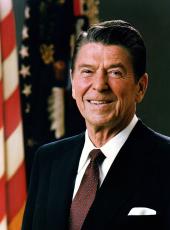I met today with Ambassadors Max Kampelman, Maynard Glitman, and Ronald Lehman, our negotiators at the nuclear and space talks (NST), which resumed on January 15 with the opening of round seven in Geneva. I took this opportunity to emphasize once again to Ambassador Kampelman, our head of delegation, and our other negotiators my full confidence in them and the very high priority which I continue to attach to the achievement of deep, equitable, and effectively verifiable reductions in the U.S. and Soviet nuclear arsenals. Such reductions would reduce the risk of war and make a major contribution to our efforts to build a safer world.
As this new negotiating round approaches, it is important to take a clear-eyed, objective look at where we are on the long and difficult road to real arms reduction agreements with the Soviet Union. Our longstanding commitment to a more secure U.S.-Soviet strategic relationship—one with far lower levels of nuclear arms—goes beyond mere words. We have taken a series of concrete steps in our efforts to move closer to this goal. Most recently, our negotiators in the last round tabled new U.S. proposals which reflect the areas of agreement General Secretary Gorbachev and I reached during our October meeting at Reykjavik as well as other new U.S. proposals. These areas of agreement, which reflect our progress at Reykjavik, include:
—reductions in strategic nuclear delivery vehicles to 1,600 for each side, with no more than 6,000 warheads on these delivery vehicles;
—an interim equal global limit of 100 warheads on longer range U.S. and Soviet INF missiles, with no such missiles in Europe;
—the need for significant cuts in Soviet heavy ICBM's; and
—the need for effective verification of agreements implementing such reductions.
In an effort to meet expressed Soviet concerns, the United States also proposed at Reykjavik that neither the United States nor U.S.S.R. deploy advanced strategic defenses through 1996, while conducting research, development, and testing which are permitted by the ABM treaty. This would be coupled with agreement that during the first 5 years of this period U.S. and Soviet strategic offensive arms would be reduced by 50 percent; that during the second 5 years all remaining U.S. and Soviet offensive ballistic missiles of all ranges and armaments would be eliminated; and that at the end of 1996 either side would have the right to deploy advanced defenses, unless the parties agreed otherwise. We have since tabled this new proposal, as well, in Geneva.
In December our negotiators went to Geneva for informal meetings with their Soviet counterparts as part of preparations for round seven. During these informal talks there was no narrowing of differences, although limited progress was made in clarifying some points of agreement between the two sides. The Soviets seemed more interested, at times, in conducting an arms control public relations campaign than in the hard give and take of the confidential negotiating process. Unfortunately, since Reykjavik, Soviet actions to move forward on arms control have not matched our own; indeed, the Soviets sometimes seem to be moving in the other direction. For example, they have backtracked from some of the important points on which Mr. Gorbachev and I reached agreement at Reykjavik.
Furthermore, at Reykjavik they reintroduced their demand that progress in every area of nuclear arms control must be linked together in a single package. This new linkage represents a major step backwards from the agreement Mr. Gorbachev and I made at our summit meeting in Geneva in November 1985 to pursue negotiations in areas where there was already common ground, including the principle of 50-percent reductions in strategic nuclear arms and an interim agreement on INF. This renewed Soviet attempt to hold progress in INF and other areas of arms control hostage to acceptance of the longstanding Soviet effort to cripple our SDI program is unacceptable to the United States and our allies, and we have made this crystal clear to the Soviet Union. Due to the strategic threat posed to the United States and our allies by the continuing Soviet offensive buildup and the extensive and longstanding Soviet programs in strategic defense, it is vital to the future security of the West that the SDI program proceed as expeditiously as possible.
The United States is ready to move forward in this new round. With the solid support of our allies and the continued support of the Congress and the American people, we will seek every opportunity to make meaningful progress towards real arms reductions. If the Soviet Union will return to Geneva with dedication equal to our own, I firmly believe the areas of progress which we have already identified can serve as the starting point from which United States and Soviet negotiators can achieve, for the first time in history, agreements on deep, equitable, and effectively verifiable reductions in our respective nuclear arsenals. Let us hope, therefore, that the Soviets will come to Geneva ready to move with us toward such historic agreements.
As I have said before, real nuclear arms reductions are within our grasp if the Soviet Union will join us in the serious pursuit of agreements which are equitable and stabilizing for both sides and in the interest of the entire world. There is much hard work ahead and many problems remaining, but we will leave no stone unturned in our search for this kind of agreement. The United States is ready; I hope the Soviets are as well.
Ronald Reagan, Statement on the Soviet-United States Nuclear and Space Arms Negotiations Online by Gerhard Peters and John T. Woolley, The American Presidency Project https://www.presidency.ucsb.edu/node/252048

